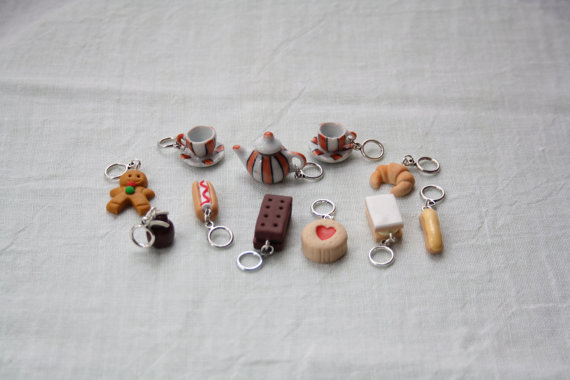There’s a good chance that, if you’re knitting a bit of clothing, you’ll at some point need to use stitch markers – especially if you’re working in the round.
While you can just as easily use a few strands of brightly coloured yarn, I much prefer ‘proper’ markers; there are so many fun, bright and beautiful stitch markers out there, and they look so cute dotted along your knitting.
I’ve been searching for more to add to my collection, and of course went straight to Etsy. So, here’s a round up of my absolute favourite stitch markers and sellers (and at the end, you’ll see the ones I actually went for!).
Rainbow Cake Stitch Marker (Korutumi) £2 each

How bright are these?! I adored the way these cake slice markers fit together to make a full cake. And Korutumi has a bunch of other lovely handmade designs, including these honeybees (save the bees!), which they make to order.
Penguin Stitch Markers (AbsoKnittingLutely) £8.50 for 4

I love penguins (who doesn’t?) and these reminded me so much of Feathers McGraw from Wallace and Gromit. The shop has a range of other novelty markers, but if you’re looking for quantity the set of 10 super colourful felted markers (picture below) could be just what you’re after.

Cards Against Humanity Markers (CalefRoadCrafts) £9.39 for 6

Okay, so these are about as far from cute and cuddly as you can get, but if you’re a fan of the gross-out game Cards Against Humanity these are the markers for you. CalefRoadCrafts also has a bunch of other geeky markers with designs from Adventure Time and Game of Thrones.
Yarn Ball Markers (HandDrawnYarn) £15 for 5

Edinburgh seller HandDrawnYarn’s beautifully handcrafted yarn ball markers really are something special. They’re available in a range of colours and would make a brilliant gift for knitting enthusiasts (i.e to me, from me, right?) – don’t forget to take a peep at the shop’s range of quirky yarn ball earrings while you’re there.
Literally everything (Stitchcuddles) roughly £4-£5 for 2, £7 for 4

What can I say about Stitchcuddles’ wonderful designs? This shop was definitely my standout favourite of the lot, and it was impossible for me to pick a favourite from shop owner Steph’s collection of good-enough-to-eat handmade markers – though if money was no object I’d have definitely plumped for the Afternoon Tea themed set (pictured above) which gets you 11 markers for £17.50. You can even pick the pattern for your tea set!


In the end I went for the Tea for Two – pictured above – with bourbon biscuits (my favourite!) instead of croissants and a floral patterned tea set. I couldn’t believe the amount of choice; you can pick from about 25 different tasty treats and every single one seems so carefully made.
I’m totally delighted with my purchase and can’t wait for them to arrive. I’ll be sure to post a picture of them in action!
Do you have a favourite shop for knitting accessories? Or are you a crafter that makes stuff like this? Let us know in the comments below. Hope you’ve had a lovely weekend!















































